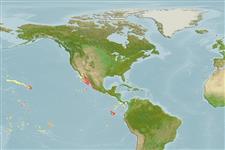Elasmobranchi (squali e razze) (sharks and rays) >
Carcharhiniformes (Ground sharks) >
Pentanchidae (Deepwater catsharks)
Etymology: Cephalurus: cephalus, from kephale (Gr.), head, referring to its expanded, flattened and rounded head; ailouros (Gr.), cat, probably an allusion to the vernacular “catshark,” so named for its cat-like eyes. (See ETYFish); cephalus: From kephale (Gr.), head, allusion not explained, probably referring to its expanded, flattened and rounded head, “much wider” and with larger pores compared with the similar Parmaturus xaniurus, its presumed congener at the time. (See ETYFish).
More on author: Gilbert.
Environment: milieu / climate zone / depth range / distribution range
Ecologia
marino batidemersale; distribuzione batimetrica 155 - 927 m (Ref. 244). Deep-water; 32°N - 15°S
Eastern Central Pacific: southern Baja California, Mexico and Gulf of California. Cephalurus specimens from Panama, Peru and Chile differ from Cephalurus cephalus and may represent one or more new species.
Length at first maturity / Size / Peso / Age
Maturity: Lm ?, range 19 - ? cm
Max length : 28.0 cm TL maschio/sesso non determinato; (Ref. 244); common length : 24.0 cm TL maschio/sesso non determinato; (Ref. 244)
Found on the upper continental slope and outermost shelf. The expanded branchial region of this shark suggests that they are adapted to bottom areas with low dissolved oxygen levels. With little information available, reproductive mode could either be ovoviviparous (Ref. 244, 53776) or oviparous, paired eggs are laid (Ref. 50449).
Oviparous, paired eggs are laid. Embryos feed solely on yolk (Ref. 50449). Other sources describe ovoviviparity as an alternative reproductive mode (Ref. 244, 53776).
Compagno, L.J.V., 1984. FAO Species Catalogue. Vol. 4. Sharks of the world. An annotated and illustrated catalogue of shark species known to date. Part 2 - Carcharhiniformes. FAO Fish. Synop. 125(4/2):251-655. Rome: FAO. (Ref. 244)
IUCN Red List Status (Ref. 130435)
Threat to humans
Harmless
Human uses
Pesca: di nessun interesse
Informazioni ulteriori
Age/SizeAccrescimentoLength-weightLength-lengthLength-frequenciesMorfometriaMorfologiaLarveDinamica popolazioni larvaliReclutamentoAbbondanzaBRUVS
BibliografiaAcquacolturaProfilo di acquacolturaVarietàGeneticaElectrophoresesEreditarietàMalattieElaborazioneNutrientsMass conversion
CollaboratoriImmaginiStamps, Coins Misc.SuoniCiguateraVelocitàModalità di nuotoArea branchialeOtolithsCervelliVista
Strumenti
Special reports
Download XML
Fonti Internet
Estimates based on models
Preferred temperature (Ref.
123201): 7.9 - 14.8, mean 9.5 °C (based on 31 cells).
Phylogenetic diversity index (Ref.
82804): PD
50 = 1.0000 [Uniqueness, from 0.5 = low to 2.0 = high].
Bayesian length-weight: a=0.00398 (0.00236 - 0.00672), b=3.06 (2.91 - 3.21), in cm total length, based on LWR estimates for this species & (Sub)family-body (Ref.
93245).
Trophic level (Ref.
69278): 3.7 ±0.4 se; based on diet studies.
Resilienza (Ref.
120179): Molto basso, tempo minimo di raddoppiamento della popolazione più di 14 anni (Fec=2).
Fishing Vulnerability (Ref.
59153): Low vulnerability (18 of 100).
